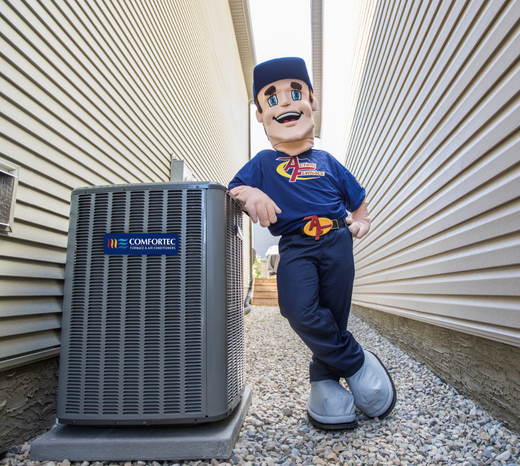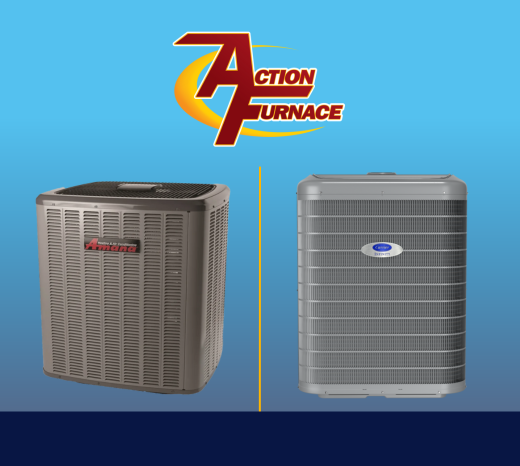A properly-sized high-efficiency air conditioner can keep your Alberta home cool for less. Learn how to buy one here and what to expect from each of your different options with advice from the Action Furance team, who have installed AC in Calgary, Edmonton, and Red Deer for years.
...

Air conditioners are increasingly vital for Alberta’s hot, dry summers—but buying a new air conditioner means knowing what kind, what size, and how to have it installed.
We’re here to help. Action Furnace has installed countless ACs throughout Calgary, Edmonton, and Red Deer, and we’ve outlined everything you need to know about the process in this guide.
Get a Quote for Your New Air Conditioner Installation
This Guide Includes
- When to Buy a New Air Conditioner
- Signs You Should Repair Your AC
- Signs You Should Replace Your AC
- What Kind of Air Conditioner to Buy
- Central AC vs. Ductless Mini-Split Systems
- Comparison Chart
- Central Air Conditioners
- How They Work
- Pros
- Cons
- Who They’re Ideal For
- Ductless Mini-Split Air Conditioners
- How They Work
- Pros
- Cons
- Who They’re Ideal For
- Central AC vs. Ductless Mini-Split Systems
- How to Buy a New Air Conditioner for Your Home
- AC Sizing Chart
- Additional Factors to Consider
- Preparing for Your Air Conditioner Installation
- Tips for Using & Maintaining Your New Air Conditioner
- Why Buy with Action Furnace?
- Industry Leading Warranties & Guarantees
- Membership Benefits
- Air Conditioners Starting from Just $59/Month
- Frequently Asked Questions about Buying an Air Conditioner
When to Buy a New Air Conditioner
Not every air conditioner problem means you need to buy a brand new one—but you should know the difference between problems that are cost-effective to repair and those that aren’t. Here’s a list of examples for each:
Signs You Should Repair Your AC
- Minor Repairs: If issues are minor and isolated, like a malfunctioning fan motor or a broken drain tube, repairing these components is usually cost-effective.
- Refrigerant Leaks: Small refrigerant leaks can often be repaired without the need for a complete system replacement.
- Electrical Problems: Issues such as faulty capacitors or a burned contactor (which are responsible for electrical flow regulation and system operation) can typically be repaired.
Signs You Should Replace Your AC
- Old Age: Air conditioners over 15 years old are prime candidates for replacement, especially as they near the end of their typical lifespan of 15-20 years.
- Rising Energy Bills: Increased energy consumption without a corresponding increase in cooling efficiency suggests that the AC unit is operating inefficiently and may need replacing.
- Low SEER Rating: Older units with low SEER ratings are less energy-efficient. Consider replacing units with a SEER rating below 14.
- Temperature Inconsistencies: Inability to maintain consistent temperatures throughout your home suggests the unit can no longer meet cooling demands
What Kind of Air Conditioner to Buy
High-Efficiency New Models vs. Older AC Unit
High-efficiency new air conditioner models offer much better energy efficiency than older units—measured by the Seasonal Energy Efficiency Ratio (SEER). The SEER rating reflects the amount of cooling an AC unit provides per watt of electricity.
Modern central AC models typically have SEER ratings of 14 or higher, whereas older models frequently have ratings under 10.
Benefits of High-Efficiency Models:
- Lower Energy Bills: Reduced energy consumption leads to significant savings on electricity costs.
- Improved Cooling Efficiency: Provides more effective cooling per unit of energy used.
- Environmentally Friendly: Less energy use means a reduced carbon footprint.
- Modern Refrigerants: Uses environmentally safer refrigerants, avoiding harmful R22.
- Enhanced Comfort: Offers better temperature control and humidity management when paired with a whole-home humidifier.
- Quieter Operation: Typically operates more quietly than older models.
Central Air Conditioners vs. Ductless Mini-Split Systems
Central air conditioners are integrated with your home's HVAC system, providing cooling throughout the entire house. They work by circulating cool air through a network of ducts and vents, offering consistent temperature control in all rooms.
Ductless mini-split systems are independent units that provide cooling to specific rooms or areas. They operate without the need for ductwork, using an outdoor compressor connected to indoor air-handling units. Each unit can be controlled independently, offering personalized cooling and flexibility in installation.
There are other types of AC as well, like window units and standalone models—but these are typically only useful in small spaces like apartments, so we’re going to focus on the types suitable for whole homes.
See Also: Different Types of Air Conditioning Units (& Which One Is Best For You)
| Central Air Conditioners | Ductless Mini-Split Systems | |
| Energy Efficiency | Average SEER ratings range from 13 to 22 | Typically higher SEER ratings, starting at 18 and up to 30 for top models |
| Upfront Price (Ballpark) | Generally costs about 30% less upfront than mini-split systems | Typically higher upfront costs due to the need for multiple units throughout a home; can be around 30% more than central systems |
| Operating Costs (Relative) | Higher utility bills, approximately 30% more annually than ductless systems; typically costs between $1,000 and $1,200 per year | Lower annual operating costs due to higher efficiency; about 30% less than central air conditioners |
| Required Maintenance (Brief) | Requires regular duct maintenance to prevent mold and mildew growth; professional cleaning recommended every 3-5 years | Less maintenance intensive; mainly involves cleaning of filters and regular checks |
| Installation Complexity | More complex due to the need for ductwork, which can add to the cost if not already present in the home | Easier and quicker to install, especially in homes without existing ductwork; requires a small hole for the refrigerant line |
Central Air Conditioners
How They Work
- Central air conditioners are integrated into your home's heating and cooling system.
- They work by cooling air that circulates through the HVAC system, ensuring consistent temperature control in all rooms.
- Typically connected to the home's electrical and duct system, these systems automatically maintain desired temperature levels and are controlled by your thermostat.
Pros
- Provides uniform cooling throughout the entire house.
- Once installed, it requires little interaction or adjustment.
- Can be more energy-efficient in the long run for larger homes.
Cons
- Higher initial installation cost and requires professional installation.
- Limited to homes with existing ductwork.
- Can require periodic maintenance, such as regular cleaning and filter replacement.
Ideal For
Larger homes or households that need consistent cooling levels in all rooms without the need for multiple standalone units.
Ductless Mini-Split Air Conditioners
How They Work
- Ductless mini-split air conditioners are compact units that provide cooling to specific rooms or areas.
- These systems have an outdoor compressor/condenser and one or more indoor air-handling units.
- They are connected by a small conduit instead of ductwork and offer targeted cooling.
Pros:
- Lower initial cost compared to central systems and flexible installation options.
- Independent control of temperature in different rooms or zones.
- More energy-efficient than window units and some central systems.
Cons:
- May require multiple units for whole-house cooling, increasing overall cost.
- Visible inside the home and can affect room aesthetics.
- Installation still requires professional service, although less invasive than central AC.
Ideal For
Individuals living in smaller spaces, homes without ductwork, or those needing temperature control in specific areas rather than throughout the entire home.
How to Buy a New Air Conditioner for Your Home
Any air conditioner you buy for your home must have an appropriate output for the space you need cooled. This ensures that the unit will be effective and use energy efficiently, keeping your bills as low as possible and prolonging the equipment’s life.
AC output is measured in Btu (British thermal units). The more Btu an AC has, the more space it can cool—although other factors also apply. Here’s a chart showing the general amount of Btu needed to cool different home sizes on average:
Other Sizing Factors
- Room Dimensions: Square footage is crucial, but also consider ceiling height and room layout.
- Window Size and Orientation: Larger or numerous windows, especially those facing south, can increase cooling needs.
- Insulation Quality: Better-insulated homes may require less cooling capacity.
- Internal Heat Sources: Appliances and electronics that generate heat can affect AC sizing.
- Number of Occupants: More people in the home generally means more cooling is needed.
- Building Materials: Materials like brick or stone can retain more heat, impacting AC requirements.
- Ventilation and Airflow: Proper ventilation affects how efficiently an AC unit cools a space.
Our team uses a complex, industry-standard calculation called the Manual-J to determine the right size of air conditioner for your home, based on these factors and others. That’s why having professionals install your AC is absolutely essential for making sure it can cool your home efficiently and help you avoid high bills or other issues.
See Also: What Size Air Conditioner Do I Need (Alberta Edition)?
Preparing for Your AC Installation
Before we install your new air conditioner, take these steps to prepare your home:
- Clear the Installation Area: Ensure the area where the air conditioner will be installed is easily accessible.
- Assess Your Home's Insulation: Evaluate the insulation in the area where the air conditioner will be installed, as this can impact its cooling efficiency.
- Plan for Electrical Upgrades: Be prepared for any necessary electrical modifications during the air conditioner installation.
Tips for Using & Maintaining Your New Air Conditioner
Proper use and maintenance are key for the longevity and efficiency of your air conditioner.
- Regular Maintenance Checks: Have your air conditioner serviced annually by our professionals to make sure it's operating at peak efficiency. Book your AC tuneup here.
- Thermostat Settings: Keep the thermostat set to a comfortable level, ideally using a programmable thermostat for better energy efficiency.
- Clean and Replace Filters Regularly: Clean or replace your air conditioner's filter at least once each month to maintain its efficiency.
- Inspect for Proper Airflow: Regularly check that air vents are not blocked and that airflow is consistent throughout your home.
- Be Alert for Leaks or Malfunctions: Watch out for any signs of refrigerant leaks, unusual noises, or other indications of malfunction and address them promptly.
See Also: 5 Ways to Make Your Air Conditioner Last Longer
Why Buy with Action Furnace?
Our team has installed air conditioners all over Calgary, Red Deer, and Edmonton. Here’s why we’re the right choice for your home:
Industry Leading Warranties & Guarantees
Our exclusive AC units some with the best warranty in the industry—12 years for parts and 12 years for labour, so that you can enjoy complete and total peace of mind. Our two-year trial guarantee also means we’ll remove the equipment and fully refund you for it if you’re not satisfied by the end of your first two years using it. Additionally we offer a $500 installation date guarantee, a customer respect guarantee, and more. See every warranty and guarantee we offer here.
Membership Benefits
Members of our Comfort Club get 10% off all future HVAC repairs, as well as access to our priority service. We’ll even call you to schedule your annual AC service so that you never miss it, making it easier than ever to keep your system in shape.
New Air Conditioners Starting from Just $59/Month
Our AC installations are some of the most cost-effective in the industry. Enjoy incredible value and easy financing on all new air conditioners we sell.
When you work with Action Furnace, you get a new air conditioner installed by the best in the business. Contact us to book your air conditioner installation and learn more by exploring the FAQ below.
Frequently Asked Questions about Buying an Air Conditioner
How Long Will a New Air Conditioner Last?
Expect a well-maintained air conditioner to last up to 15 years. Regular maintenance and prompt repairs, especially after 10 years, can extend its lifespan. Action Furnace offers a 12-Year Parts & Labour Warranty on AC installations.
How Long Does AC Installation Take?
Installation time varies based on factors like ductwork quality, installation space, AC unit size, and access ease. Most installations complete within a day. Action Furnace provides accurate installation timeline estimates.
Can I Install an Air Conditioner Myself?
DIY installation is not recommended—it can damage ductwork and affect your warranty. Professional installation is the best way to make sure your cooling system is set up properly and safely.
How Much Does AC Installation Cost?
Costs vary based on home size, system type, ductwork condition, and other factors, but the typical range for a central AC is from about $6,500 to $12,000. Contact Action Furnace for a precise quote.



